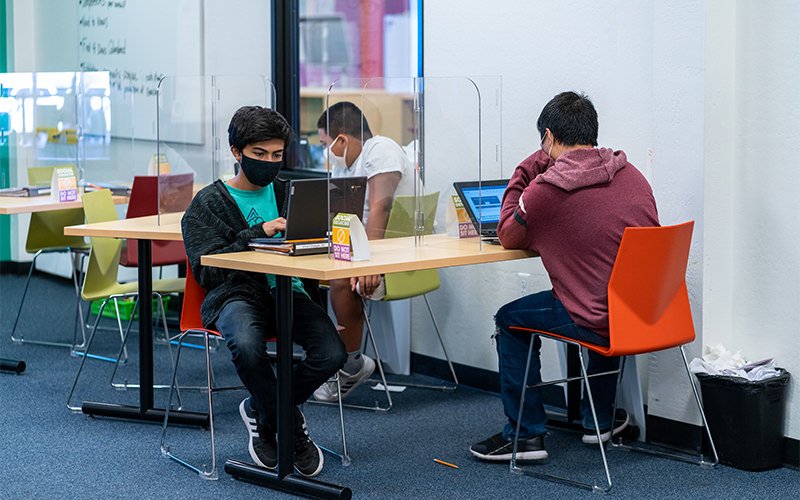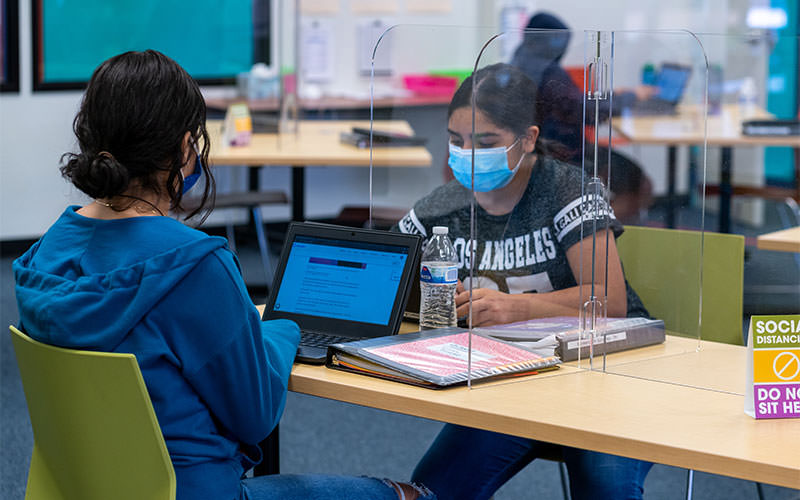
Phoenix International Academy is among Maricopa County schools that have resumed in-person classes, with masks, social distancing, physical barriers and enhanced sanitizing. (Photo courtesy of U.S. Department of Education)
With some Arizona districts opening their campuses and welcoming students back into physical classrooms, many parents in Maricopa County want information on how to keep kids safe from COVID-19 outbreaks. The county is home to 58 school districts that serve more than 700,000 students.
Since the start of the school year in August, Maricopa County has reported 30 outbreaks in schools, with 28 current active cases – but understanding the numbers requires parents to do a bit of hunting. Many parents are being asked to rely on email notifications and updates to keep track of what is happening at their school.
To ease the process, the Maricopa County Department of Public Health created a Schools COVID-19 Dashboard, where residents can track data about the disease along with updated information on school outbreaks. An outbreak is defined as two or more students or staff, who have only been in close contact through the school, testing positive in a 14 day period.
The information will help districts choose the learning environments they provide to students and allow families to monitor the disease in their neighborhoods to make informed decisions.
How do I find a specific school?
To be honest, it’s not easy. Reports are available based on ZIP code, city and school district. Specific schools can be searched, but they don’t have individual reports on Maricopa County’s dashboard.
Border areas of the county, where ZIP codes, cities or districts overlap into other counties, may not be accurately represented on the dashboard, which only includes data from within Maricopa County.
The number of active cases per school is not included on the county’s dashboard, but some districts are providing that information. An active case is someone who tested positive and had been in-person learning or part of any on-campus activity. Once that person is cleared to return to school, his or her case will be removed from the district’s dashboard.
The districts providing this information include: Laveen Elementary School District, Chandler Unified School District, Deer Valley Unified School District, Gilbert Public Schools District, Fountain Hills Unified School District, Mesa Public Schools District, Peoria Unified School District and Tempe Union High School District.
Scottsdale Unified School District includes both in-person and at-home students on its dashboard data of cases per school.
Madison Elementary School District and Higley Unified School District provide the number of active cases as well as recovered cases, while Paradise Valley Unified School District provides the number of weekly new cases and each school’s cumulative number of cases since Oct. 5.
East Valley Institute of Technology is providing weekly updates on the number of new cases that are confirmed on its two campuses.
Phoenix Union High School District tracks information and accesses risk levels based on information from ZIP codes where the schools are located and where students and staff live, and it says it soon will provide data on positive COVID-19 cases within the district.
What information is provided?
A community report from Maricopa County includes an overall risk level assessment and the recommended learning scenario. The report provides two weeks of data for three benchmarks: the number of new cases per 100,000 people, the percent positivity of tests and the percent of COVID-like illnesses.
Tests included in the data are nasal and throat swabs and saliva-based testing. Schools do not conduct testing, but they screen anyone entering campus for possible symptoms.
The COVID-like illness percentage refers to how many visits to an emergency room and hospitalizations are due to symptoms of COVID-19, the disease caused by the novel coronavirus, and is monitored through a county-wide “surveillance system.”
What does each classification mean?
Overall risk level is determined by community spread, which is when people become infected without a traceable source of exposure, according to the Centers for Disease Control and Prevention.
Arizona officials outline three levels of risk, determined by the three benchmarks and following guidelines established by the CDC. The highest risk level benchmark shown determines the overall risk level of the community.
A minimal risk level means there is no proof of exposure in a large, communal setting. This level includes fewer than 10 positive cases per 100,000 people each week, and a rate of percent positivity and instances of COVID-like illness less than 5%.
A moderate risk level shows sustained community spread and can point to a potential increase in cases. This means there are between 10 and 100 positive cases per 100,000 people, a percent positivity between 5% to 10% or a percent of COVID-like illnesses between 5% and 10%.
Substantial risk indicates large scale community spread. This is shown by more than 100 positive cases per 100,000 people, a percent positivity higher than 10% or a percentage of COVID-like illnesses more than 10%.
How can my school return to traditional, or in-person, instruction?
Schools that maintain a minimal risk level for two weeks can move to a traditional learning environment of students in buildings.
When moving to traditional learning, the Arizona Department of Education requires local education agencies to communicate screening expectations to students and staff. Other operational adaptations that follow CDC guidelines are recommended, such as keeping students 6 feet apart, developing cleaning policies for communal areas and encouraging anyone who feels sick to stay home.

Schools that maintain a minimal level of infection risk for two weeks can move to a traditional learning environment of students in buildings. (Photo courtesy of U.S. Department of Education)
What if my school doesn’t qualify for in-person instruction?
Schools with a moderate risk level have the option of a hybrid learning environment or a virtual one with on-site support.
Hybrid learning allows some students to be in the building while others are distance learning, which is any learning approach where students are not physically present in a classroom.
To qualify for hybrid learning, a school’s benchmarks must qualify as either moderate or minimal for two consecutive weeks, during which the percent positivity remains less than 7%.
Although the benchmark for a moderate risk level requires less than 10% of all COVID-19 tests done in a week throughout a community to be positive, this percentage must be less than 7% for a school to move to hybrid learning. After the two weeks, a school can remain hybrid as long as the tests done in the community continue to have a positivity rate less than 10%.
The other option for schools at moderate risk and for schools labeled at substantial risk is a virtual learning environment, where all students are distance learning.
What if I can’t keep my student at home?
On-site support is a physical space available to students in a virtual learning environment who need a place to go during the school day or have specific needs that require support.
Facilities vary, but under an executive order by Gov. Doug Ducey, school districts and charter schools are required to provide on-site support services throughout the school year. To comply with physical distancing recommendations, however, schools may restrict the number of students who receive on-site support. And in the case of a large outbreak, a district can apply for an on-site support services waiver.
What happens after a school reopens?
After a school moves to hybrid or traditional instruction, Maricopa County encourages continual monitoring of the area that “best represents a school’s student body.”
The first week a community sees an increase in any of the benchmarks from minimal to moderate, officials recommend a transition from a traditional environment. If the community does not go back to a minimal level the next week, a transition to hybrid or virtual learning is recommended.
If a community sees a benchmark increase from either minimal or moderate up to substantial, officials encourage schools to prepare for a possible transition. If the data does not show the benchmark dropping to the lower risk level in the second week, schools should transition to a virtual environment with on-site support.
How often is this information updated?
Maricopa County officials will update the dashboard by 9 a.m. on Thursdays.
For more recent updates and information on ZIP codes outside Maricopa County, you can visit the state’s data dashboard.
Districts’ websites include their specific reopening plans, learning options and resources available to families and what is expected of students that are able to return to campus.


